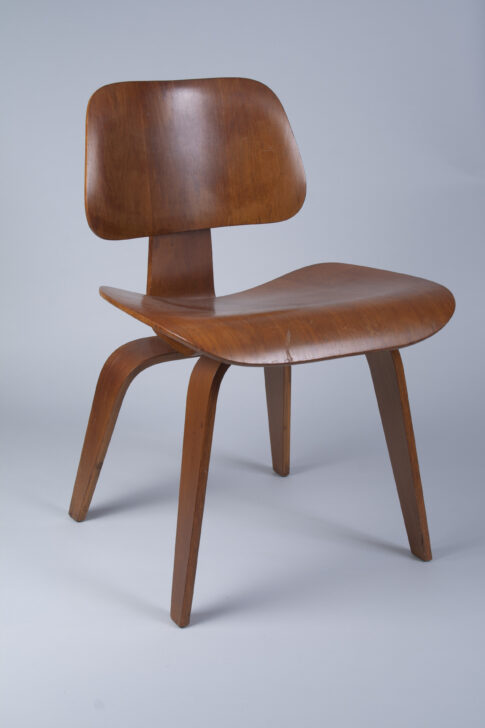DCW (Dining Chair Wood)
Charles Eames; Ray Eames

Description
Gallery Rotations Spring 2013
Charles and Ray Eames
United States, 1907–78 and 1912–88
Thanks to the husband and wife team of Charles and Ray Eames, the innovations of modern design became accessible to the general public. Not only did the Eameses take full advantage of mass-production to “make the best for the most for the least”—high-quality, low-cost objects for the average consumer—but they also favored an attractive, approachable aesthetic. Their designs became American “classics,” embraced both by design experts and the expanding middle-class of the post-WWII boom.
The Eameses met at the Cranbrook Academy of Art in Bloomfield Hills, Michigan, part of the Cranbrook experimental educational community, but soon settled in southern California. Both environments promoted a critical approach to the functionalist, one-size-fits-all ideals of European modernism. The Eameses excelled at satisfying both the demands of industrial production and deeper, more intangible, human needs—a fusion that came to be known as “organic” modernism. They constantly explored ways to endow new materials, technologies, and media with sensual and psychological appeal, along with the comfort, informality, and playfulness associated with California living.
Charles and Ray Eames
United States, 1907–78 and 1912–88
DCM (Dining Chair Metal)
Molded oak plywood, welded steel rods, and rubber shock mounts
DCW (Dining Chair Wood)
Molded walnut veneer plywood with rubber shock mounts
circa 1946
Manufactured by Evans Products Company, Molded Plywood Division, and distributed by Herman Miller Furniture Company
Gift of Herbert and Susan Johe, 2012/1.288, 2012/1.287
The separate, trapezoidal seats and backs of these plywood chairs form an abstract composition oscillating in two- and three-dimensional space, reminiscent of Ray Eames’s modernist work in painting, sculpture, and graphic design. As the Eameses’ first big commercial success, these chairs brought modernism’s abstract simplicity and innovative, unadorned materials into the middle-class home.
Since 1940 the Eameses had been trying to mold plywood into a unified “shell”: a single, compound curve that would replace the distinct planes of a chair’s seat and back. This visual coherence was ultimately at odds with the realities of mass-manufacturing plywood, but their alternative design turned out to have a number of advantages. Less complex parts enabled efficient mass production. Connected via flexible shock mounts (their first use in furniture), separate components had greater resiliency. Finally, the biomorphic seat and back on a spine-like frame gave these chairs an animated, human quality. On display at the Museum of Modern Art, they caught the eye of the Herman Miller Furniture Company, which bought the rights to the designs and financed the Eameses’ future experiments.
Physical Description:
Four-legged plywood side chair consisting of a trapezoidal seat and back connected by a wooden spine.
Usage Rights:
If you are interested in using an image for a publication, please visit https://umma.umich.edu/request-image/ for more information and to fill out the online Image Rights and Reproductions Request Form.